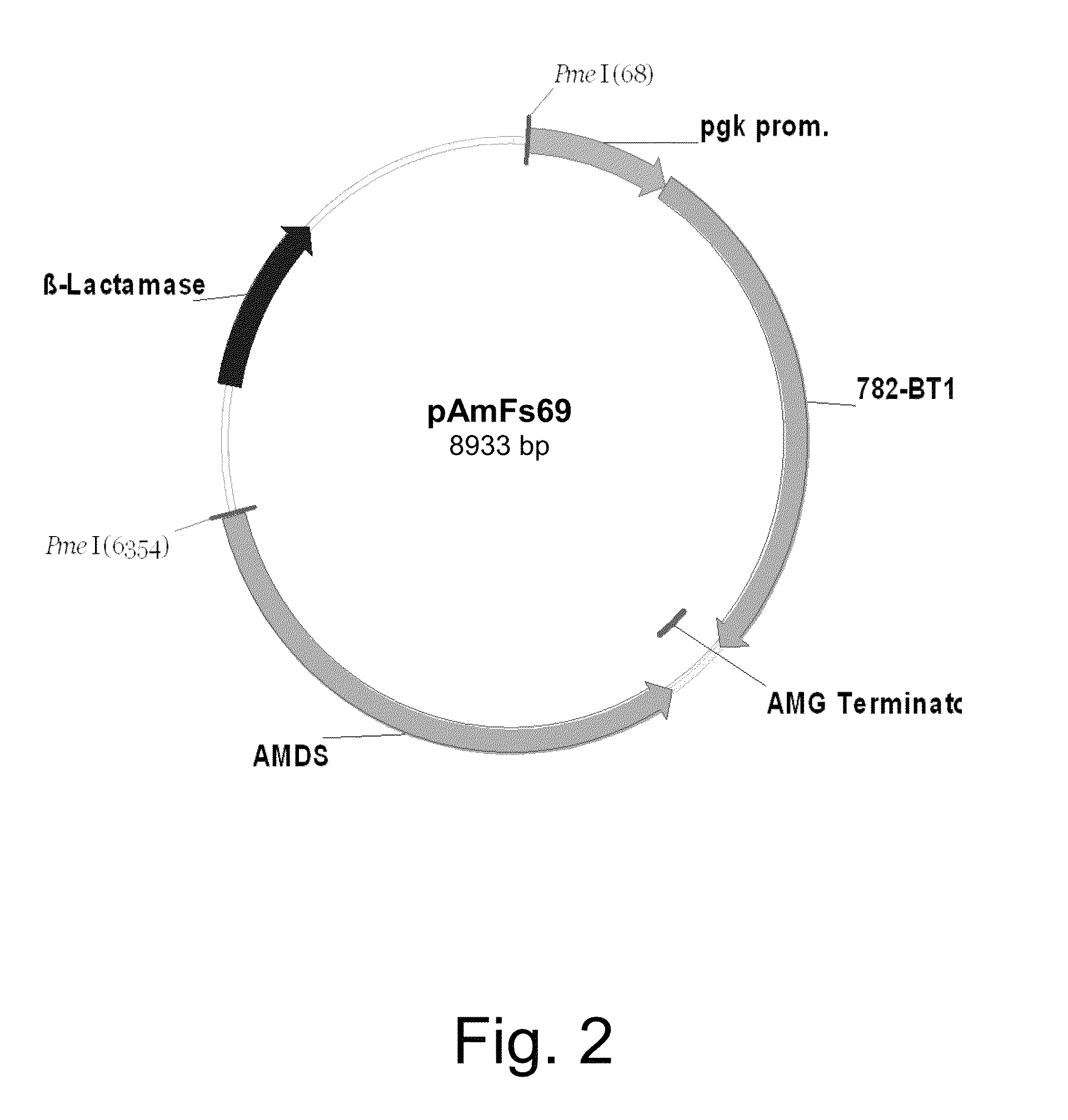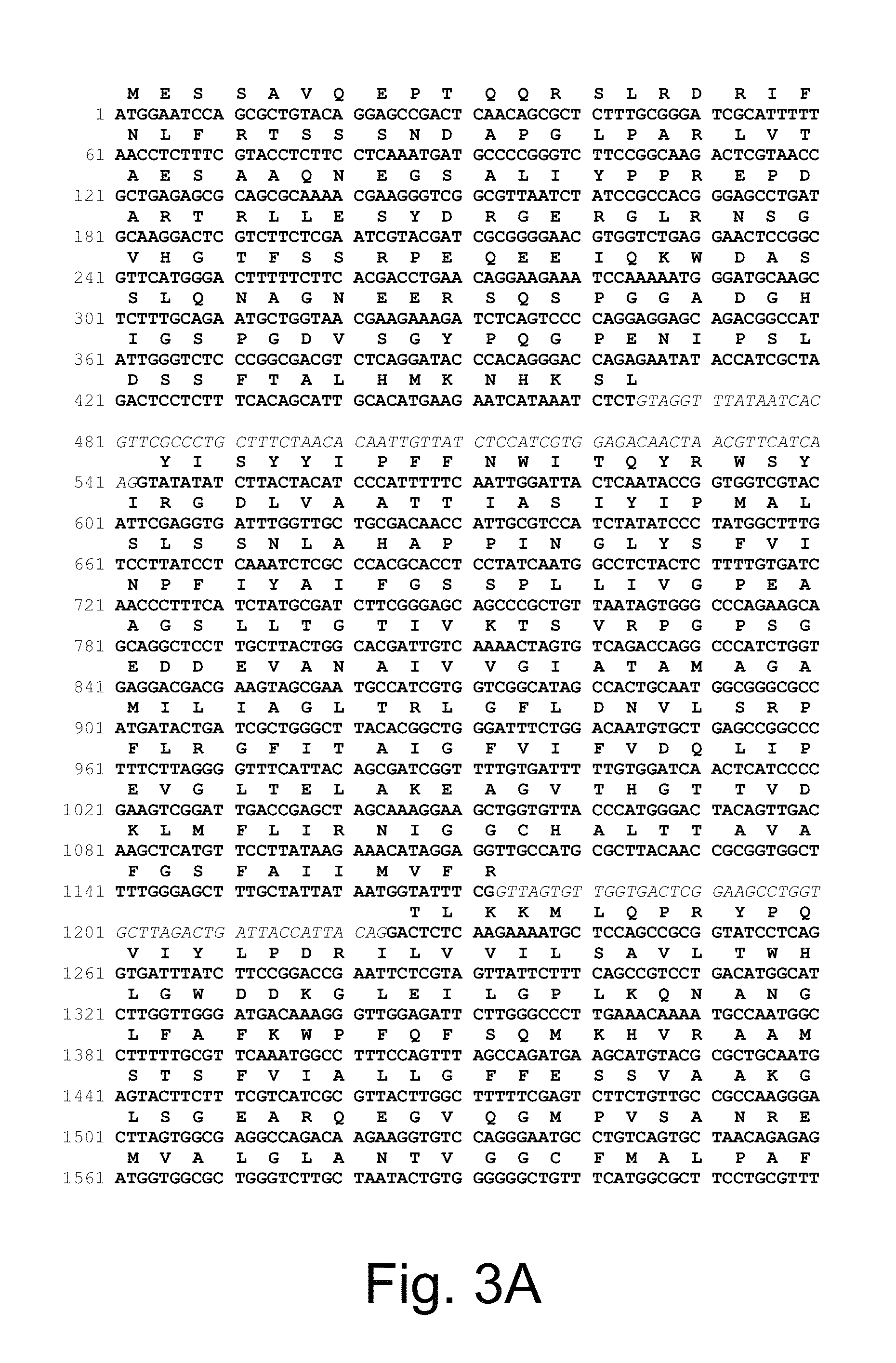Recombinant microorganisms for production C4-dicarboxylic acids
- Summary
- Abstract
- Description
- Claims
- Application Information
AI Technical Summary
Benefits of technology
Problems solved by technology
Method used
Image
Examples
example 1
Cloning of an Aspergillus oryzae Bicarbonate Transporter Gene (bt1) and Construction of Expression Vector pAmFs69
[0278]The bicarbonate transporter gene bt1 (AO090012000782) was cloned from Aspergillus oryzae NRRL3488 genomic DNA by PCR amplification using primers homologous to the Aspergillus oryzae predicted bicarbonate transporter gene model number AO090012000782 found in the published A. oryzae ATCC 42149 genome sequence (Galagan et al., 2005, Nature 438: 1105-1115).
[0279]Genomic DNA from A. oryzae NRRL3488 was isolated by inoculating 100 ml YEG medium in a shake flask with 2×106 spores and incubating the flask at 37° C. overnight with shaking at 200 rpm. The mycelia were harvested in MIRACLOTH® (Calbiochem, San Diego, Calif., USA) lined funnel and approximately 2 grams of tissue was frozen in liquid nitrogen. The mycelia were disrupted by grinding in a cold mortar and pestle. Genomic DNA was isolated from the powdered mycelia using a DNeasy® Plant Maxi Kit (QIAGEN Inc., Valencia...
example 2
Cloning of an Aspergillus oryzae Bicarbonate Transporter Gene AO090003000798 and Construction of Corresponding Expression Vector
[0287]The bicarbonate transporter gene bt2 (AO090003000798) was cloned from Aspergillus oryzae NRRL3488 genomic DNA by PCR amplification using primers homologous to the Aspergillus oryzae predicted bicarbonate transporter gene model number AO090003000798 found in the published A. oryzae ATCC 42149 genome sequence (Galagan et al., 2005, supra).
[0288]Genomic DNA from A. oryzae NRRL3488 was isolated and the mycelia were harvested and processed as described in Example 1. The Aspergillus oryzae bt2 gene was amplified using forward primer 0614058 and reverse primer 0614057 shown below:
[0289]
Primer 0614058:(SEQ ID NO: 63)5′-GTGATAGAACATCGTCCATAATGCCGGGCGATCTCAAAACC-3′Primer 0614057:(SEQ ID NO: 64)5′-GTGTCAGTCACCTCTAGTTACTATGCATCAAGGACATTC-3′
[0290]The amplification reactions were performed using Phusion® Hot Start High-Fidelity DNA Polymerase (Finnzymes) according ...
example 3
Cloning of an Aspergillus aculeatus C4-Dicarboxylic Acid Transporter Gene and Construction of Expression Vector pSaMF36
[0296]Genomic DNA from Aspergillus aculeatus was isolated by inoculating 100 ml of YEG medium in a shake flask with 2×106 spores and incubating the flask at 34° C. overnight with shaking at 160 rpm. The mycelia were harvested by filtration using a MIRACLOTH®(Calbiochem) lined funnel and approximately 2 g of mycelia were recovered and frozen in liquid nitrogen. The frozen mycelia were disrupted by quickly smashing with a hammer while wrapped inside the MIRACLOTH®. The disrupted mycelia were then transferred to a 50 ml polypropylene conical centrifuge tube containing 10 ml of 1× lysis buffer (100 mM EDTA, 10 mM Tris pH 8.0, 1% Triton® X-100, 0.5 M Guanidine-HCl, 200 mM NaCl) and 3 μl of RNase A (QIAGEN Inc.; 100 mg / ml). The tube was mixed by gentle vortexing, and then incubated at room temperature for 5 minutes after which was added 150 μl Proteinase K (QIAGEN Inc.; 2...
PUM
| Property | Measurement | Unit |
|---|---|---|
| Temperature | aaaaa | aaaaa |
| Temperature | aaaaa | aaaaa |
| Temperature | aaaaa | aaaaa |
Abstract
Description
Claims
Application Information
 Login to View More
Login to View More - R&D
- Intellectual Property
- Life Sciences
- Materials
- Tech Scout
- Unparalleled Data Quality
- Higher Quality Content
- 60% Fewer Hallucinations
Browse by: Latest US Patents, China's latest patents, Technical Efficacy Thesaurus, Application Domain, Technology Topic, Popular Technical Reports.
© 2025 PatSnap. All rights reserved.Legal|Privacy policy|Modern Slavery Act Transparency Statement|Sitemap|About US| Contact US: help@patsnap.com



